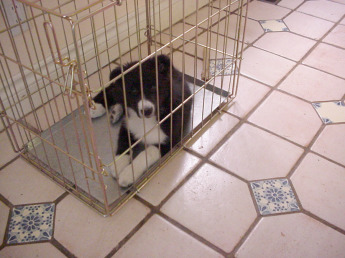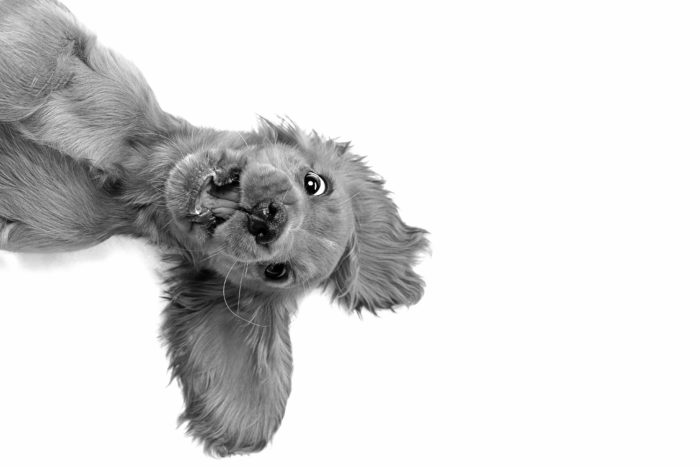Daily Routine – Why Structure is Important
Although the use of the crate is helpful while teaching a puppy where you want them to go to the bathroom, it is not the only reason we recommend its use. Puppies will engage in behaviors you won’t like if they are left to wander around the house unattended. You can refer to the How Dogs Learn section for more information on this. Puppies will chew off-limit items, they will jump up to explore tables and counters, they will eat whatever appeals to them, and they will sleep in the most comfortable spot.
This in itself does not sound so bad until you consider that without your supervision, your pup will chew on your prized photo album collection, eat your child’s chocolate Easter Egg (toxic to a dog), and lie on your two hundred dollar duvet while eating it.
Another great reason for the structure is proper rest. Young pups need 18 – 20 hours of sleep in a 24-hour span. Lack of proper rest may be associated with excessive puppy biting. Providing our pups downtime will also help them learn to self regulate as they mature. They will be able to lie down and settle. Being unable to settle can manifest into pacing and whining or barking at people they see passing by the window.

Avoid plush bedding in the crate with puppies that are still learning to “hold it”.
- Stay engaged! Play, Train, Cuddle, Explore, Offer Enrichment Activities.
- Supervise everything he is doing.
- Offer frequent bathroom breaks.
- Do some kind of socializing, or preventative styled exercise, or
- Play a game with him, or
- Allow him supervised freedom.
- When you are sleeping.
- When he needs a break.
- When you need a break.
- When the kids are playing.
- When you are out of the house.
Puppies need a fair amount of rest. Putting him in his crate after socialization, playtime, or training or will allow both of you some time to yourself. You can give him something yummy to chew on while he is in there (a toy made specifically to be stuffed with food or treats that your dog can safely chew on). It is also a good idea to take him out to go to the bathroom before you crate him. Whenever possible, give the puppy some exercise prior to crate time.
It seems natural to let the pup hang out in the backyard. The puppy is outside having fun, what could go wrong? Unfortunately, this is not the case. Don’t make the mistake of assuming that you can leave the pup outside in the backyard unattended. The same rules that apply inside will exist here. A puppy left on his own will develop habits you do not want. They get bored out in the yard alone. He may dig in your garden…everywhere. He may bark at the neighbor. He may chew up your grass, trees and shrubs. He may even escape. If your puppy is in the backyard, be there with him and stay engaged.
The downside is that issues such as bathroom training, chewing, and structure & boundaries may not be as successful using these alternatives.
We recognize that not everyone can come to terms with the use of a crate. We also know how disastrous it can be to give a puppy open access to the house. So there are alternatives that, although not as proficient as a crate, will provide the puppy with some safety. The downside is that issues such as bathroom training, chewing, and structure may not be as successful using these alternatives.
- Confine the puppy in the kitchen. Ensure that there is nothing the pup can get into or chew.
- Use an X-pen (or similar structure) to confine the puppy.
We wish to provide you with all the information you need to have a better understanding of what a crate was designed to do and why so many dog people, veterinarians, trainers, and groomers recommend its use. When used properly it a crate has long been established as a helpful and humane tool to use when raising a dog.
- Take your puppy directly outside every single time he comes out of his crate.
- The crate should be large enough for the puppy to turn around in and lie down. It should not be huge.
- Do not keep his feed and water dish in the crate (use a stuffed food toy instead).
- Provide the puppy with a special chew toy or two that will keep him busy and satisfied versus ten stuffed animals.
- Avoid plush bedding with puppies that are still learning to hold it.
- Ideally, a crate should never be positioned where a dog can see outside the home. The puppy will see other dogs, animals, and people and want to be with them. This can cause undue aggravation and frustration for the puppy.
- The locations should be cool and out of direct sunlight.
- Never leave your dog in the crate for longer than he can manage.
- It is nice to cover a wire crate to make it dark and cozy inside. This may promote rest and a relaxed comfortable state of mind.
If your puppy is peeing or pooing in the crate; rule out any health concerns with a trip to the vet, provide more frequent bathroom breaks, consider removing the bedding or making the space in the crate smaller.
Please check the Equipment List regarding crates.

